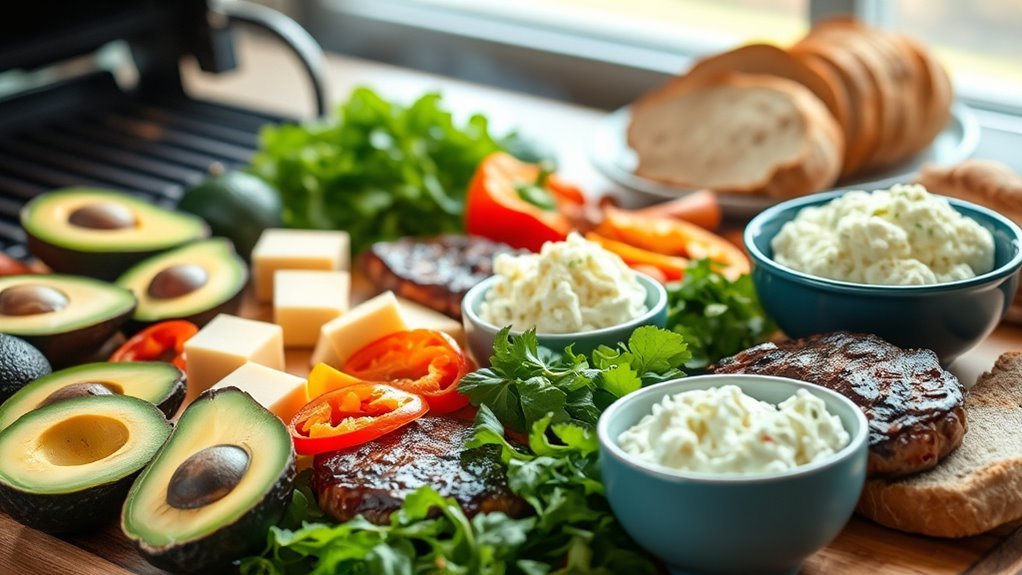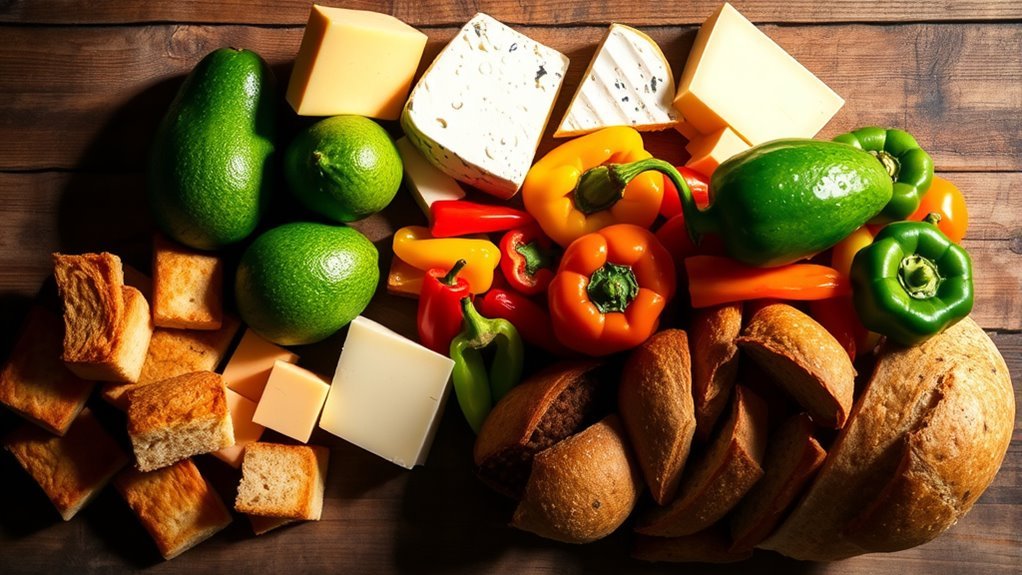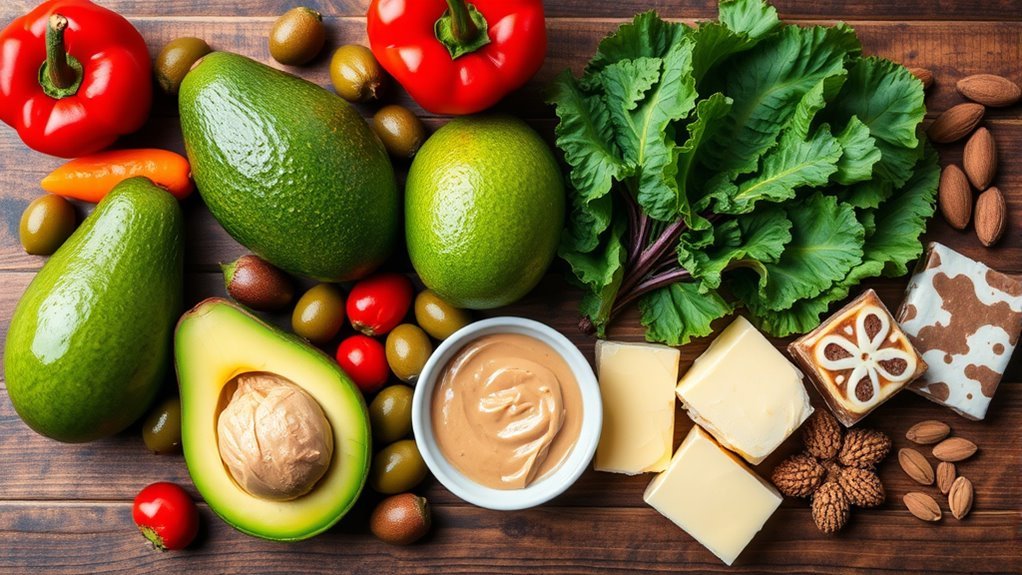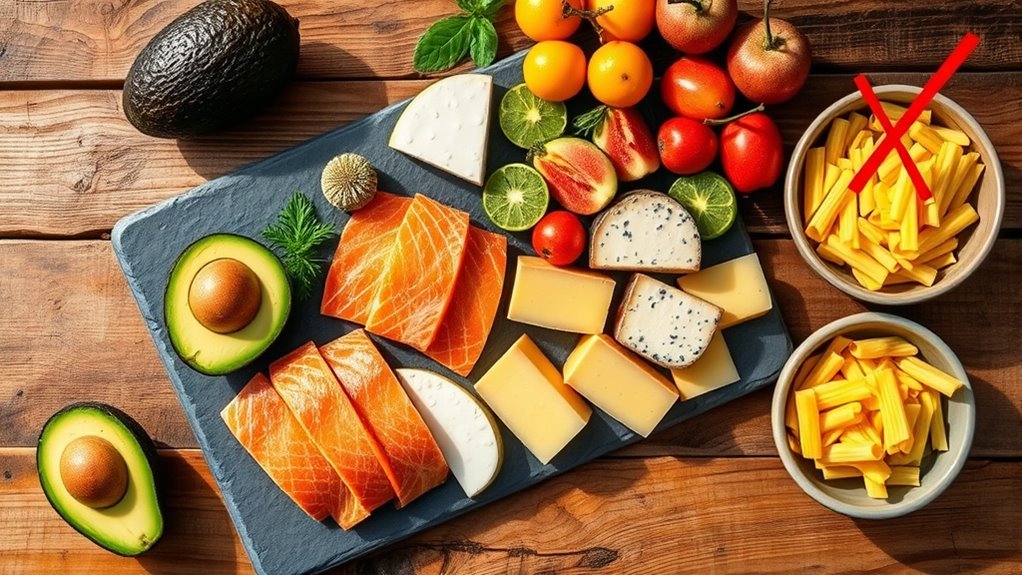On a keto diet, focus on eating healthy fats like avocado, olive oil, and fatty fish, along with low-carb vegetables such as spinach and cauliflower. Include protein sources like eggs, chicken, and nuts for balanced meals. Avoid high-carb foods like bread, pasta, and sugary snacks, as well as hidden carbs in sauces and processed snacks. Understanding food choices can enhance your experience and support your goals, and there’s more to discover about maneuvering this lifestyle.
Understanding Ketosis and Its Benefits

When you switch to a ketogenic diet, your body enters a state called ketosis, which can lead to various health benefits. Ketosis explained is fundamentally a metabolic process where your body burns fat for fuel instead of carbohydrates. This shift can enhance energy levels, improve mental clarity, and support weight loss by utilizing stored fats. A benefits overview reveals that many people experience reduced hunger, stabilized blood sugar levels, and better cholesterol profiles. Additionally, some studies suggest that ketosis may have therapeutic effects for certain neurological disorders. Embracing a keto lifestyle gives you the freedom to explore diverse food choices while reaping these potential rewards. Understanding ketosis can empower you to make informed decisions on your health journey.
Essential Foods to Include in Your Keto Diet

To successfully maintain a keto diet, it’s vital to include a variety of essential foods. Focus on healthy fats, low-carb vegetables, and protein-rich foods to guarantee you’re meeting your nutritional needs while staying in ketosis. By incorporating these elements, you’ll support your health and enhance your overall keto experience.
Healthy Fats Sources
Healthy fats are essential in a keto diet, as they not only provide energy but also support overall health and satiety. Including a variety of healthy fats can enhance your meals and keep you satisfied. Here’s a quick reference table to guide you:
| Source | Benefits | Suggestions |
|---|---|---|
| Avocado | Rich in fiber and heart-healthy fats | Add to salads or smoothies |
| Coconut Oil | Boosts energy with MCTs | Use for cooking |
| Olive Oil | Anti-inflammatory properties | Drizzle on veggies |
| Nut Varieties | Packed with nutrients | Snack or mix in yogurt |
| Fatty Fish | High in omega-3s | Grill or bake |
Incorporate cheese options, chia seeds, and grass-fed products for added nutrition and flavor. Enjoy the freedom of a diverse, healthful keto diet!
Low-Carb Vegetables
Incorporating low-carb vegetables into your keto diet is important for maintaining nutritional balance while keeping carbohydrate intake in check. These keto friendly vegetables provide essential vitamins, minerals, and fiber without sabotaging your carb limits. Opt for nutrient-dense options like spinach, kale, broccoli, and zucchini, which serve as excellent low carb alternatives. They not only enhance your meals but also support overall health. You can enjoy them in salads, stir-fries, or as side dishes, allowing for versatility in your cooking. Remember, while following a keto lifestyle, it’s important to prioritize these vegetables to achieve your health goals. Embrace the freedom to enjoy a variety of flavors while staying true to your dietary choices!
Protein-Rich Foods
Low-carb vegetables are just one part of a well-rounded keto diet; protein-rich foods also play an essential role in supporting your nutritional needs. To maximize protein quality and nutrient absorption, consider these options:
- Lean meats like chicken, turkey, and grass-fed beef
- Fish such as salmon and mackerel, packed with omega-3 fatty acids
- Vegetarian options like tofu, tempeh, and legumes for plant-based proteins
- Protein supplements for convenient meal prepping and protein timing
Healthy Fats: The Cornerstone of Keto

While many diets emphasize cutting fats to lose weight, the keto diet flips this notion on its head by making healthy fats a vital component of its framework. Incorporating healthy fats, like avocados, nuts, and olive oil, provides essential fatty acids that fuel your body and promote satiety. When choosing cooking methods, opt for techniques that preserve these fats, such as sautéing or roasting instead of frying. This way, you’re not only enhancing flavor but also maintaining the nutritional benefits. By embracing healthy fats, you can enjoy a satisfying diet that encourages weight loss while providing energy and nutrients. Remember, the right fats can liberate you from cravings and keep you feeling full, making your keto journey both enjoyable and effective.
Low-Carb Vegetables for Nutritional Balance
When following a keto diet, incorporating low-carb vegetables is essential for maintaining nutritional balance. Options like spinach, zucchini, and broccoli not only keep your carb count low but also provide crucial vitamins and minerals. By choosing nutrient-dense vegetables, you can support overall health while enjoying the benefits of a ketogenic lifestyle.
Best Low-Carb Options
Incorporating a variety of low-carb vegetables into your diet is essential for maintaining nutritional balance on a keto journey. These veggies not only provide fiber but also essential vitamins and minerals. Here are some of the best low-carb options to evaluate:
- Spinach: Packed with iron and vitamins A and C.
- Zucchini: Versatile and low-calorie, perfect for zoodles.
- Cauliflower: Great for creating rice or a keto-friendly pizza crust.
- Broccoli: High in fiber and antioxidants.
Alongside these, you can enjoy the best low-carb snacks and indulge in keto-friendly desserts while ensuring you meet your nutritional needs. Embrace these options to keep your meals exciting and satisfying without straying from your keto goals!
Nutrient-Dense Choices
Choosing the right low-carb vegetables can greatly enhance your keto diet, as they not only help keep your carb count in check but also provide essential nutrients. Leafy greens like spinach and kale are excellent choices, packed with vitamins A, C, and K, which support nutrient absorption. Cruciferous veggies, such as broccoli and cauliflower, are low in carbs and high in fiber, promoting ideal digestion. Don’t forget about zucchini and bell peppers, which add color and flavor while keeping your meals exciting. Staying hydrated is vital on keto, so consider incorporating vegetables with high water content, like cucumbers. By selecting these nutrient-dense options, you’re setting yourself up for a balanced and satisfying keto experience. Enjoy the freedom of delicious, healthy eating!
Protein Sources That Support Ketosis
While following a ketogenic diet, selecting the right protein sources is essential for maintaining ketosis and supporting overall health. You’ll want to focus on a variety of protein options that not only fit your macros but also aid muscle recovery. Here are some excellent choices:
- Lean meats like chicken and turkey
- Dairy options such as Greek yogurt and cheese
- Seafood choices including salmon and shrimp
- Egg varieties like whole eggs and egg whites
Incorporating plant proteins and protein powders can also be beneficial, but remember to practice portion control. Pay attention to protein timing, especially after workouts, to maximize recovery and sustain your energy levels while enjoying your ketogenic journey.
Foods to Avoid on a Keto Diet
To successfully maintain a ketogenic diet, you need to be mindful of the foods that can hinder your progress towards ketosis. Avoid high-carb items like bread, pasta, and sugary snacks that can derail your efforts. When selecting keto snacks, check food labels for hidden sugars and carb counts. Sugar substitutes can be tricky; some still spike insulin levels. Be cautious with alcohol choices, as many have hidden carbs that can impact your state of ketosis. During meal prep, focus on low-carb ingredients and practice portion control. When dining out, don’t hesitate to ask about meal timing and ingredient sources. Explore recipe ideas that align with your goals to keep your meals exciting and compliant.
Hidden Carbs: What to Watch Out For
How can hidden carbs sneak into your diet and sabotage your keto goals? These sneaky sources can derail your progress if you’re not careful. Here’s what to watch out for:
- Hidden sugars in sauces and dressings, often found in seemingly healthy options.
- Processed snacks that claim to be low-carb but are loaded with carbs when you check the labels.
- Condiment choices like ketchup or barbecue sauce that can pack a surprising carb punch.
- Unexpected sources such as certain nuts or dairy products that contain more carbs than you’d expect.
Always read food labels and be mindful during meal prep to avoid these pitfalls. Staying vigilant guarantees you maintain your keto freedom while enjoying your meals!
Sample Keto Meal Plans for Beginners
Maneuvering hidden carbs can be tricky, especially when you’re starting your keto journey. A simple meal plan can help you stay on track. For breakfast, consider keto breakfast ideas like scrambled eggs with spinach or a chia seed pudding topped with berries. Lunch could include a salad with grilled chicken, avocado, and a low-carb dressing. Don’t forget to incorporate keto snack options, such as cheese sticks or a handful of nuts, to keep your energy up throughout the day. For dinner, try baked salmon with asparagus or a stir-fry featuring your favorite low-carb vegetables. By following these meal suggestions, you’ll enjoy freedom in your food choices while keeping your carb intake low.


